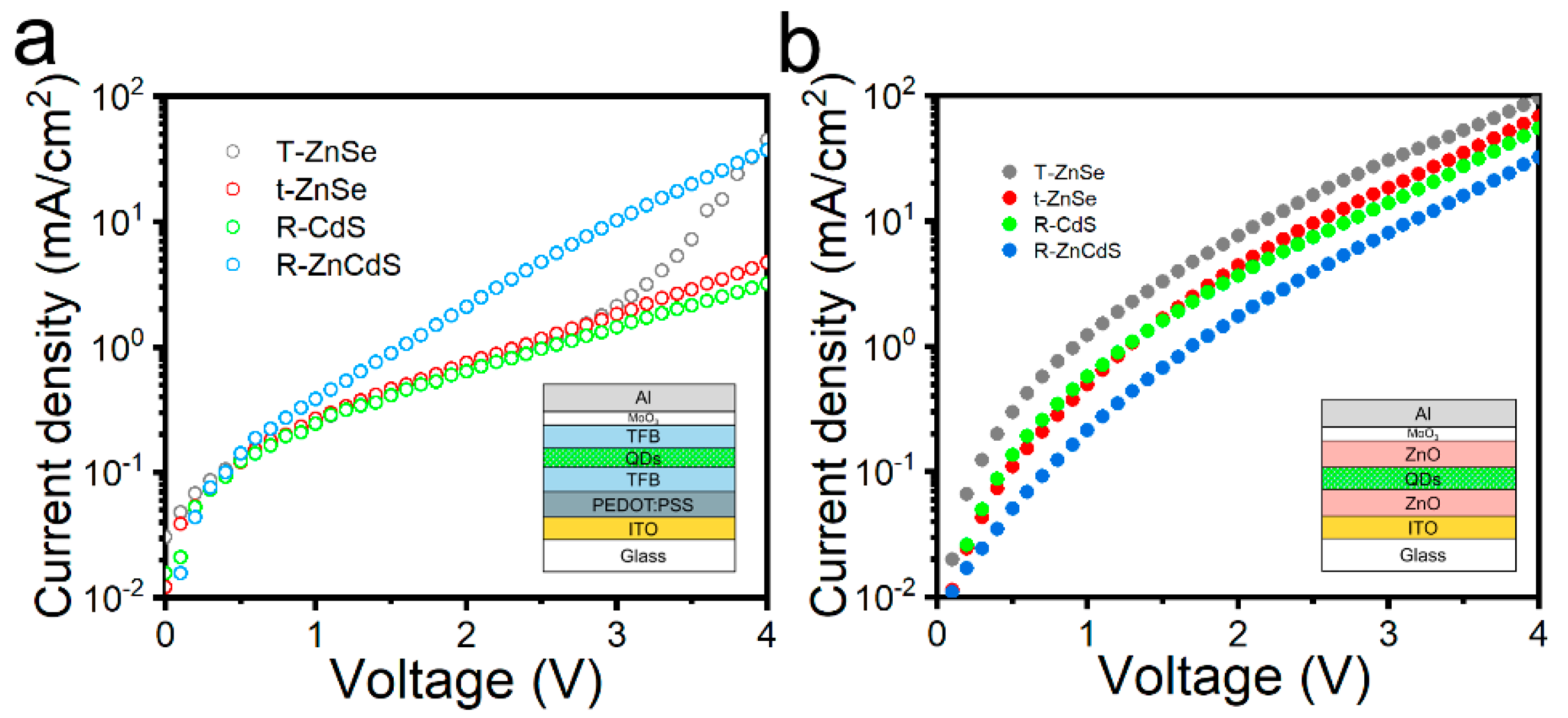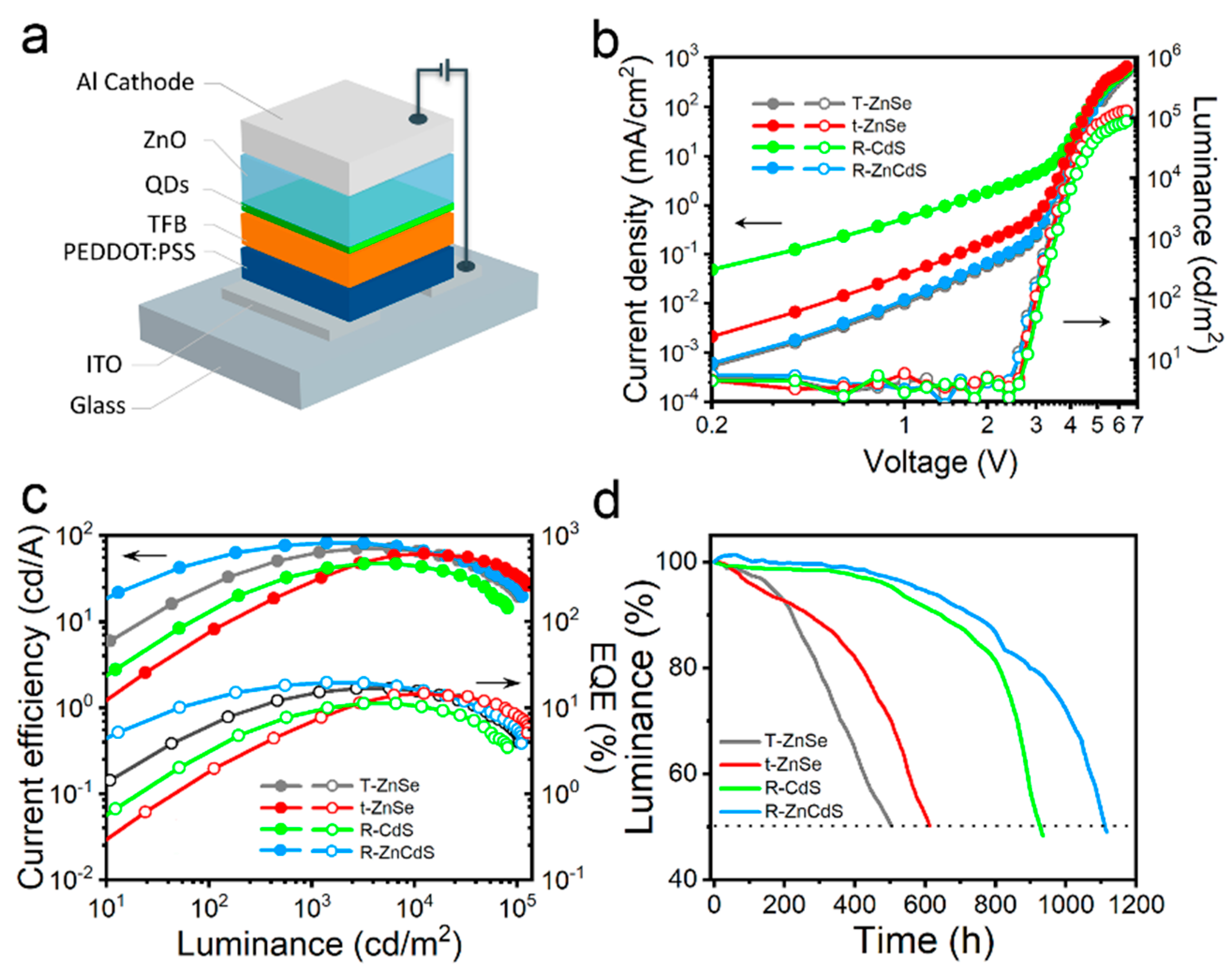Spectra Stable Quantum Dots Enabled by Band Engineering for Boosting Electroluminescence in Devices
Abstract
:1. Introduction
2. Materials and Methods
2.1. Synthesis of Quantum Dots by Band Engineering
2.2. Synthesis of Zinc Oxide Nanocrystals (ZnO NPs)
2.3. Device Fabrication
2.4. Characterization
3. Results and Discussion
4. Conclusions
Author Contributions
Funding
Data Availability Statement
Conflicts of Interest
References
- Bae, W.K.; Char, K.; Hur, H.; Lee, S. Single-step synthesis of quantum dots with chemical composition gradients. Chem. Mater. 2008, 20, 531. [Google Scholar] [CrossRef]
- Nan, W.; Niu, Y.; Qin, H.; Cui, F.; Yang, Y.; Lai, R.; Lin, W.; Peng, X. Crystal Structure Control of Zinc-Blende CdSe/CdS Core/Shell Nanocrystals: Synthesis and Structure-Dependent Optical Properties. J. Am. Chem. Soc. 2012, 134, 19685. [Google Scholar] [CrossRef]
- Bae, W.K.; Nam, M.K.; Char, K.; Lee, S. Gram-Scale One-Pot Synthesis of Highly Luminescent Blue Emitting Cd1-xZnxS/ZnS Nanocrystals. Chem. Mater. 2008, 20, 5307. [Google Scholar] [CrossRef]
- Pietryga, J.M.; Park, Y.-S.; Lim, J.; Fidler, A.F.; Bae, W.K.; Brovelli, S.; Klimov, V.I. Spectroscopic and Device Aspects of Nanocrystal Quantum Dots. Chem. Rev. 2016, 116, 10513. [Google Scholar] [CrossRef]
- Jun, S.; Jang, E. Bright and stable alloy core/multishell quantum dots. Angew Chem. Int. Ed. 2013, 52, 679. [Google Scholar] [CrossRef]
- Kagan, C.R.; Lifshitz, E.; Sargent, E.H.; Talapin, D.V. Building devices from colloidal quantum dots. Science 2016, 353, 885. [Google Scholar] [CrossRef]
- Chen, D.S.; Chen, D.; Dai, X.L.; Zhang, Z.X.; Lin, J.; Deng, Y.Z.; Hao, Y.L.; Zhang, C.; Zhu, H.M.; Gao, F.; et al. Shelf-Stable Quantum-Dot Light-Emitting Diodes with High Operational Performance. Adv. Mater. 2020, 32, 2006178. [Google Scholar] [CrossRef]
- Shen, H.B.; Gao, Q.; Zhang, Y.B.; Lin, Y.; Lin, Q.L.; Li, Z.H.; Chen, L.; Zeng, Z.P.; Li, X.G.; Jia, Y.; et al. Visible quantum dot light-emitting diodes with simultaneous high brightness and efficiency. Nat. Photon. 2019, 13, 192. [Google Scholar] [CrossRef]
- Yang, Y.X.; Zheng, Y.; Cao, W.R.; Titov, A.; Hyvonen, J.; Manders, J.R.; Xue, J.G.; Holloway, P.H.; Qian, L. High-efficiency light-emitting devices based on quantum dots with tailored nanostructures. Nat. Photon. 2015, 9, 259. [Google Scholar] [CrossRef]
- Dai, X.; Zhang, Z.; Jin, Y.; Niu, Y.; Cao, H.; Liang, X.; Chen, L.; Wang, J.; Peng, X. Solution-processed, high-performance light-emitting diodes based on quantum dots. Nature 2014, 515, 96. [Google Scholar] [CrossRef]
- Kim, T.; Kim, K.H.; Kim, S.; Choi, S.M.; Jang, H.; Seo, H.K.; Lee, H.; Chung, D.Y.; Jang, E. Efficient and stable blue quantum dot light-emitting diode. Nature 2020, 586, 385. [Google Scholar] [CrossRef] [PubMed]
- Won, Y.H.; Cho, O.; Kim, T.; Chung, D.Y.; Kim, T.; Chung, H.; Jang, H.; Lee, J.; Kim, D.; Jang, E. Highly efficient and stable InP/ZnSe/ZnS quantum dot light-emitting diodes. Nature 2019, 575, 634. [Google Scholar] [CrossRef] [PubMed]
- Lee, T.; Kim, B.J.; Lee, H.; Hahm, D.; Bae, W.K.; Lim, J.; Kwak, J. Bright and Stable Quantum Dot Light-Emitting Diodes. Adv. Mater. 2021, 34, 2106276. [Google Scholar] [CrossRef]
- Lee, H.; Jeong, B.G.; Bae, W.K.; Lee, D.C.; Lim, J. Surface state-induced barrierless carrier injection in quantum dot electroluminescent devices. Nat. Commun. 2021, 12, 5669. [Google Scholar] [CrossRef]
- Bae, W.K.; Park, Y.-S.; Lim, J.; Lee, D.; Padilha, L.A.; McDaniel, H.; Robel, I.; Lee, C.; Pietryga, J.M.; Klimov, V.I. Controlling the influence of Auger recombination on the performance of quantum-dot light-emitting diodes. Nat. Commun. 2013, 4, 2661. [Google Scholar] [CrossRef] [PubMed]
- Zhang, Q.; Chang, C.; Zhao, W.F.; Li, Q.C.; Li, F.; Jin, X.; Zhao, F.; Chen, Z.P.; Li, Q.H. Bright and efficient quantum dot light-emitting diodes with double light-emitting layers. Opt. Lett. 2018, 43, 5925. [Google Scholar] [CrossRef] [PubMed]
- Su, Q.; Sun, Y.Z.; Zhang, H.; Chen, S.M. Origin of Positive Aging in Quantum-Dot Light-Emitting Diodes. Adv. Sci. 2018, 5, 1800549. [Google Scholar] [CrossRef] [PubMed]
- Kim, T.; Won, Y.H.; Jang, E.; Kim, D. Negative Trion Auger Recombination in Highly Luminescent InP/ZnSe/ZnS Quantum Dots. Nano Lett. 2021, 21, 2111. [Google Scholar] [CrossRef]
- Yang, J.; Choi, M.K.; Yang, U.J.; Kim, S.Y.; Kim, Y.S.; Kim, J.H.; Kim, D.H.; Hyeon, T. Toward Full-Color Electroluminescent Quantum Dot Displays. Nano Lett. 2021, 21, 26. [Google Scholar] [CrossRef]
- Zhang, N.; Qu, X.W.; Lyu, Q.; Wang, K.; Sun, X.W. Highly efficient transparent quantum-dot light-emitting diodes based on inorganic double electron-transport layers. Photonics Res. 2021, 9, 1979. [Google Scholar] [CrossRef]
- Zhang, H.; Yuan, Q.; Wang, T.; Xue, X.; Yuan, Y.; Zhang, H.; Zhou, M.; Ji, W. Unraveling the effect of shell thickness on charge injection in blue quantum-dot light-emitting diodes. Appl. Phys. Lett. 2021, 119, 243504. [Google Scholar] [CrossRef]
- Lim, J.; Park, Y.-S.; Wu, K.; Yun, H.J.; Klimov, V.I. Droop-Free Colloidal Quantum Dot Light-Emitting Diodes. Nano Lett. 2018, 18, 6645. [Google Scholar] [CrossRef]
- Cao, H.; Ma, J.; Huang, L.; Qin, H.; Meng, R.; Li, Y.; Peng, X. Design and Synthesis of Antiblinking and Antibleaching Quantum Dots in Multiple Colors via Wave Function Confinement. J. Am. Chem. Soc. 2016, 138, 15727. [Google Scholar] [CrossRef]
- Garcia de Arquer, F.P.; Talapin, D.V.; Klimov, V.I.; Arakawa, Y.; Bayer, M.; Sargent, E.H. Semiconductor quantum dots: Technological progress and future challenges. Science 2021, 373, 640. [Google Scholar] [CrossRef] [PubMed]
- Cho, H.C.; Pan, J.A.; Wu, H.Q.; Lan, X.Z.; Coropceanu, I.; Wang, Y.Y.; Cho, W.J.; Hill, E.A.; Anderson, J.S.; Talapin, D.V. Direct Optical Patterning of Quantum Dot Light-Emitting Diodes via In Situ Ligand Exchange. Adv. Mater. 2020, 32, 2003805. [Google Scholar] [CrossRef]
- Ma, Z.W.; Tang, L.P.; Lyu, B.B. Highly efficient full color light-emitting diodes based on quantum dots surface passivation engineering. Org. Electron. 2019, 70, 140. [Google Scholar]
- Lim, J.; Bae, W.K.; Kwak, J.; Lee, S.; Lee, C.; Char, K. Perspective on synthesis, device structures, and printing processes for quantum dot displays. Opt. Mater. Express 2012, 2, 594. [Google Scholar] [CrossRef]
- Li, X.; Zhao, Y.-B.; Fan, F.; Levina, L.; Liu, M.; Quintero-Bermudez, R.; Gong, X.; Quan, L.N.; Fan, J.Z.; Yang, Z.; et al. Bright colloidal quantum dot light-emitting diodes enabled by efficient chlorination. Nat. Photon. 2018, 12, 159. [Google Scholar] [CrossRef]
- Jeong, B.G.; Chang, J.H.; Hahm, D.; Rhee, S.; Park, M.; Lee, S.; Kim, Y.; Shin, D.; Park, J.W.; Lee, C.; et al. Interface polarization in heterovalent core-shell nanocrystals. Nat. Mater. 2022, 21, 246. [Google Scholar] [CrossRef] [PubMed]
- Vafaie, M.; Fan, J.Z.; Najarian, A.M.; Ouellette, O.; Sagar, L.K.; Bertens, K.; Sun, B.; de Arquer, F.P.G.; Sargent, E.H. Colloidal quantum dot photodetectors with 10-ns response time and 80% quantum efficiency at 1,550 nm. Matter 2021, 4, 1042. [Google Scholar] [CrossRef]
- Voznyy, O.; Thon, S.M.; Ip, A.H.; Sargent, E.H. Dynamic Trap Formation and Elimination in Colloidal Quantum Dots. J. Phys. Chem. Lett. 2013, 4, 987. [Google Scholar] [CrossRef] [PubMed]
- Hames, B.C.; Mora-Sero, I.; Sanchez, R.S. Device performance and light characteristics stability of quantum-dot-based white-light-emitting diodes. Nano Res. 2018, 11, 1575. [Google Scholar] [CrossRef]
- Ji, Y.; Wang, M.; Yang, Z.; Qiu, H.; Kou, S.; Padhiar, M.A.; Bhatti, A.S.; Gaponenko, N.V. Pressure-Driven Transformation of CsPbBrI2 Nanoparticles into Stable Nanosheets in Solution through Self-Assembly. J. Phys. Chem. Lett. 2020, 11, 9862. [Google Scholar] [CrossRef] [PubMed]
- Cao, F.; Wang, S.; Wang, F.J.; Wu, Q.Q.; Zhao, D.W.; Yang, X.Y. A Layer-by-Layer Growth Strategy for Large-Size InP/ZnSe/ZnS Core-Shell Quantum Dots Enabling High-Efficiency Light-Emitting Diodes. Chem. Mater. 2018, 30, 8002. [Google Scholar] [CrossRef]





| Structure | τ1 (ns) | τ2 (ns) | f1 (%) | f2 (%) | T (ns) |
|---|---|---|---|---|---|
| T-ZnSe | 4.9 | 22.9 | 15.6 | 84.4 | 20.1 |
| t-ZnSe | 4.7 | 23.6 | 18.0 | 82.0 | 20.2 |
| R-CdS | 6.9 | 24.5 | 13.7 | 86.3 | 22.1 |
| R-ZnCdS | 4.1 | 23.8 | 12.9 | 87.1 | 21.3 |
| Quantum Dots | CE (cd/A) | Lmax (cd/m2) | EQE(%) | Lifetime (h)@1000 cd/m2 |
|---|---|---|---|---|
| T-ZnSe | 70.5 | 103,410 | 16.8 | 504 |
| t-ZnSe | 61.6 | 129,260 | 14.7 | 612 |
| R-CdS | 47.2 | 81,200 | 11.2 | 924 |
| R-ZnCdS | 82.0 | 112,290 | 19.6 | 1104 |
Publisher’s Note: MDPI stays neutral with regard to jurisdictional claims in published maps and institutional affiliations. |
© 2022 by the authors. Licensee MDPI, Basel, Switzerland. This article is an open access article distributed under the terms and conditions of the Creative Commons Attribution (CC BY) license (https://creativecommons.org/licenses/by/4.0/).
Share and Cite
Lyu, B.; Hu, J.; Chen, Y.; Ma, Z. Spectra Stable Quantum Dots Enabled by Band Engineering for Boosting Electroluminescence in Devices. Micromachines 2022, 13, 1315. https://doi.org/10.3390/mi13081315
Lyu B, Hu J, Chen Y, Ma Z. Spectra Stable Quantum Dots Enabled by Band Engineering for Boosting Electroluminescence in Devices. Micromachines. 2022; 13(8):1315. https://doi.org/10.3390/mi13081315
Chicago/Turabian StyleLyu, Bingbing, Junxia Hu, Yani Chen, and Zhiwei Ma. 2022. "Spectra Stable Quantum Dots Enabled by Band Engineering for Boosting Electroluminescence in Devices" Micromachines 13, no. 8: 1315. https://doi.org/10.3390/mi13081315
APA StyleLyu, B., Hu, J., Chen, Y., & Ma, Z. (2022). Spectra Stable Quantum Dots Enabled by Band Engineering for Boosting Electroluminescence in Devices. Micromachines, 13(8), 1315. https://doi.org/10.3390/mi13081315






